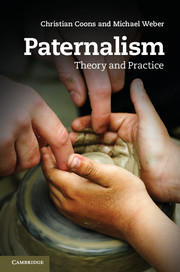Book contents
- Frontmatter
- Contents
- Contributors
- Introduction Paternalism – Issues and trends
- Chapter 1 Defining paternalism
- Chapter 2 Penal paternalism
- Chapter 3 Self-sovereignty and paternalism
- Chapter 4 The right to autonomy and the justification of hard paternalism
- Chapter 5 Moral environmentalism
- Chapter 6 Kantian paternalism and suicide intervention
- Chapter 7 Paternalism and the principle of fairness
- Chapter 8 Paternalism in economics
- Chapter 9 Choice Architecture: A mechanism for improving decisions while preserving liberty?
- Chapter 10 A psychological defense of paternalism
- Chapter 11 Libertarian paternalism, utilitarianism, and justice
- Chapter 12 Voluntary enslavement
- Chapter 13 Paternalism, (school) choice, and opportunity
- Bibliography
- Index
Chapter 9 - Choice Architecture: A mechanism for improving decisions while preserving liberty?
Published online by Cambridge University Press: 05 February 2013
- Frontmatter
- Contents
- Contributors
- Introduction Paternalism – Issues and trends
- Chapter 1 Defining paternalism
- Chapter 2 Penal paternalism
- Chapter 3 Self-sovereignty and paternalism
- Chapter 4 The right to autonomy and the justification of hard paternalism
- Chapter 5 Moral environmentalism
- Chapter 6 Kantian paternalism and suicide intervention
- Chapter 7 Paternalism and the principle of fairness
- Chapter 8 Paternalism in economics
- Chapter 9 Choice Architecture: A mechanism for improving decisions while preserving liberty?
- Chapter 10 A psychological defense of paternalism
- Chapter 11 Libertarian paternalism, utilitarianism, and justice
- Chapter 12 Voluntary enslavement
- Chapter 13 Paternalism, (school) choice, and opportunity
- Bibliography
- Index
Summary
Introduction
Extensive research in the social sciences has shed light on two important phenomena. One is that human decision-making is full of predictable errors and biases that often lead individuals to make choices that defeat their own ends. For example, individuals incorrectly predict what will make them happy in the future and are biased towards short-term consequences over long-term ones despite attaching more importance to their long-term goals. Let us call this the “bad choice phenomenon.” The second phenomenon is that individuals’ decisions and behaviors are powerfully shaped by their environment in logically irrelevant ways; they are impacted by the order in which options are presented, or tone in which they are presented, and even the smell in the room. Let us call this the “influence phenomenon.”
Some have argued that it is ethically defensible that the influence phenomenon be utilized to address the bad choice phenomenon. They propose that “choice architects” learn about the various ways to influence choices and then work to design environments, broadly construed, that promote choices that make people better off. Specifically, choice architects can influence individuals by arranging the order or tone of the presented options, offering incentives, utilizing social norms, offering vivid examples or representations, creating an anchor for thought processes, having them write down an intention or action plan, engaging them in commitment strategies, creating a default, and mapping choice consequences to something that they care about such as money.
- Type
- Chapter
- Information
- PaternalismTheory and Practice, pp. 178 - 196Publisher: Cambridge University PressPrint publication year: 2013
- 19
- Cited by

